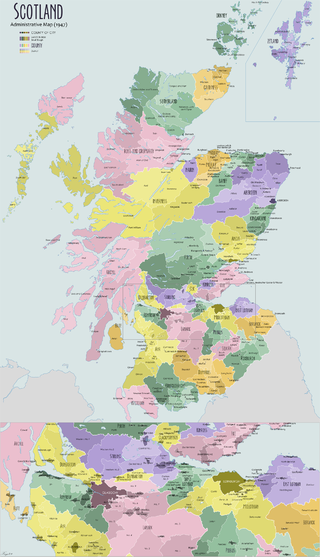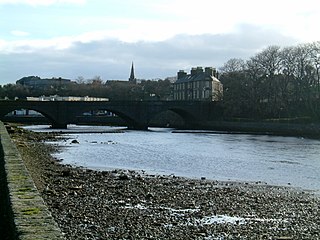Sheriffs of Caithness
- William Sinclair, 1st Earl of Caithness, 1455–1470
- John Sinclair
The Sheriff of Caithness was historically the royal official responsible for enforcing law and order in Caithness, Scotland.
The sheriffdom of Caithness appears to have been created in the mid 12th century and to have been dissolved and incorporated into the sheriffdom of Inverness in the 13th century. in 1455, William Sinclair, Earl of Caithness gained a grant of the justiciary and sheriffdom of the area from the Sheriff of Inverness. Prior to 1748 most sheriffdoms were held on a hereditary basis. From that date, following the Jacobite uprising of 1745, the hereditary sheriffs were replaced by salaried sheriff-deputes, qualified advocates who were members of the Scottish Bar.
In 1747, the office became known as the Sheriff of Caithness & Sutherland, however the sheriffdoms were disunited in 1806 again being known as the Sheriff of Caithness. It became the Sheriff of Sutherland & Caithness in 1857. [1] In 1870 the office became known as the Sheriff of Caithness, Orkney & Shetland. [2] It was again reorganised as the Sheriff of Caithness, Sutherland, Orkney & Zetland in 1946, but was abolished in 1975 when the current sheriffdom of Grampian, Highland and Islands was created.

The shires of Scotland, or counties of Scotland, are historic subdivisions of Scotland established in the Middle Ages and used as administrative divisions until 1975. Originally established for judicial purposes, from the 17th century they started to be used for local administration purposes as well. The areas used for judicial functions (sheriffdoms) came to diverge from the shires, which ceased to be used for local government purposes after 1975 under the Local Government (Scotland) Act 1973.

Caithness is a historic county, registration county and lieutenancy area of Scotland.

Wick is a town and royal burgh in Caithness, in the far north of Scotland. The town straddles the River Wick and extends along both sides of Wick Bay. "Wick Locality" had a population of 6,954 at the time of the 2011 census, a decrease of 3.8% from 2001.
Inverness was a county constituency of the House of Commons of the Parliament of the United Kingdom from 1918 until 1983. It elected one Member of Parliament (MP) by the first-past-the-post system of election.
Commissioners of Supply were local administrative bodies in Scotland from 1667 to 1930. Originally established in each sheriffdom to collect tax, they later took on much of the responsibility for the local government of the counties of Scotland. In 1890 they ceded most of their duties to the county councils created by the Local Government (Scotland) Act 1889. They were finally abolished in 1930.
The Sheriff of Argyll was historically a royal officer charged with enforcing the king's rights in Argyll; in Scotland, the concept of sheriff gradually evolved into a judicial position.

The Sheriffs (Scotland) Act 1747 was an Act of the Parliament of Great Britain which applied only to Scotland. It stated that anyone who was prosecuted on or after 1 April 1748 for treason or misprision of treason could be tried anywhere in Scotland if the crime had been committed in any of the shires of Dunbartain, Stirling, Perth, Kincardine, Aberdeen, Inverness, Nairn, Cromarty, Argyll, Forfarshire, Banff, Sutherland, Caithness, Elgine, Ross, and Orkney. Normally a crime had to be tried in the shire where it had been committed. The Act also said that in such a trial, the jurors could come from adjoining counties, instead of the county where the trial was held.
The Sheriff of Ayr was historically the royal official responsible for enforcing law and order in Ayr, Scotland and bringing criminals to justice. Sundrum Castle was used by the sheriff from the 14th century, and Loudoun Castle from the 16th century. Prior to 1748 most sheriffdoms were held on a hereditary basis. From that date, following the Jacobite uprising of 1745, the hereditary sheriffs were replaced by salaried sheriff-deputes, qualified advocates who were members of the Scottish Bar.
The Sheriff of Lanark or Sheriff of Lanarkshire was historically the royal official responsible for enforcing law and order and bringing criminals to justice in Lanarkshire, Scotland. Prior to 1748 most sheriffdoms were held on a hereditary basis. From that date, following the Jacobite uprising of 1745, the hereditary sheriffs were replaced by salaried sheriff-deputes, qualified advocates who were members of the Scottish Bar.
A sheriffdom is a judicial district of Scotland. Originally identical to the Shires of Scotland, from the eighteenth century many counties were grouped to form "sheriffdoms".
The Sheriff of Bute was historically the office responsible for enforcing law and order on the Isle of Bute, Scotland and bringing criminals to justice.
The Sheriff of Aberdeen was a royal official who was responsible for enforcing justice in Aberdeenshire, Scotland. Prior to 1748 most sheriffdoms were held on a hereditary basis. From that date, following the Jacobite uprising of 1745, they were replaced by salaried sheriff-deputies, qualified advocates who were members of the Scottish Bar.
The Sheriff of Dumfries and Galloway, was historically the royal official responsible for enforcing law and order in Dumfries and Galloway, Scotland. Prior to 1748 most sheriffdoms were held on a hereditary basis. From that date, following the Jacobite uprising of 1745, the hereditary sheriffs were replaced by salaried sheriff-deputes, qualified advocates who were members of the Scottish Bar.
The Sheriff of Roxburgh was historically the royal official responsible for enforcing law and order in that area of Scotland. Prior to 1748 most sheriffdoms were held on a hereditary basis. From that date, following the Jacobite uprising of 1745, the hereditary sheriffs were replaced by salaried sheriff-deputes, qualified advocates who were members of the Scottish Bar.
The Sheriff of Perth was historically a royal official, appointed for life, who was responsible for enforcing justice in Perth, Scotland. Prior to 1748 most sheriffdoms were held on a hereditary basis. From that date, following the Jacobite uprising of 1745, the hereditary sheriffs were replaced by salaried sheriff-deputes, qualified advocates who were members of the Scottish Bar.
The Sheriff of Ross, Cromarty and Sutherland was historically the office responsible for enforcing law and order in Ross-shire, Cromarty and Sutherland, Scotland and bringing criminals to justice.
The Sheriff of Inverness was historically the office responsible for enforcing law and order and bringing criminals to justice in Inverness, Scotland. Prior to 1748 most sheriffdoms were held on a hereditary basis. From that date, following the Jacobite uprising of 1745, the hereditary sheriffs were replaced by salaried sheriff-deputes, qualified advocates who were members of the Scottish Bar.
The Sheriff of Sutherland was historically a royal appointment, held at pleasure, which carried the responsibility for enforcing justice in the sheriffdom of Sutherland, Scotland. It became a heritable post in the hands of the Earls of Sutherland until 1747, when it reverted, in combination with Caithness, to being a Royal appointment, usually for life.
The Sheriff of Orkney and Shetland, also known as the Sheriff of Orkney and Zetland, was historically the royal official responsible for enforcing law and order in Orkney and Shetland, Scotland. The office was combined with the role in Shetland of the "foud" and the "foudry". The foud was a bailiff who returned customs and rents due the crown, including butter and oil known as "fat goods".
The Sheriff Principal of Grampian, Highland and Islands is the head of the judicial system of the sheriffdom of Grampian, Highland and Islands, one of the six sheriffdoms covering the whole of Scotland. The sheriffdom employs a number of legally qualified sheriffs who are responsible for the hearing of cases in thirteen Sheriffs Courts based in Aberdeen, Banff, Elgin, Fort William, Inverness, Kirkwall, Lerwick, Lochmaddy, Peterhead, Portree, Stornoway, Tain and Wick. The current Scottish sheriffdoms were created in 1975 when the previous arrangement of 12 sheriffdoms was discontinued.